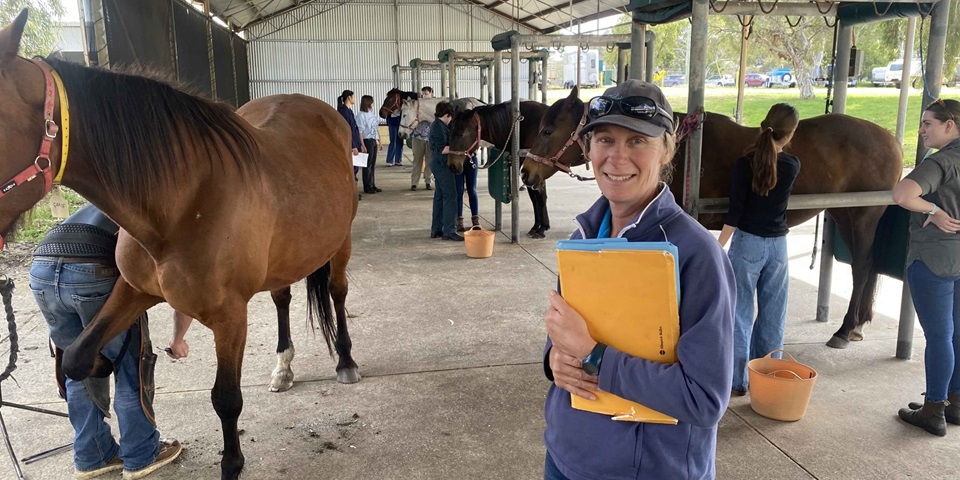student story
Learning beyond the classroom: hands-on horse management

At Murdoch University, Agricultural Science courses focus on hands-on learning in real labs, field trips and work placements. Read on for a student's perspective on getting hands-on learning helping with the management of the horses on the campus farm.
Article by Jenny Lodge (third year Agricultural Science Student)
Recently, while completing Advanced Agricultural Career Skills (ANS305), I have had the greatest pleasure of refreshing my equine handling skills with experience in managing the horses at the Murdoch Farm. This involved 40 hours spent with the mares brought in for routine farrier care provided by Mr Kim Broad of Goodlands Farrier School with team Amy, Tom and Sian.
During the weekly visits, each mare was inspected and assessed for static and dynamic conformation whilst standing still and moving. This was followed by their hooves being trimmed according to the requirements for each horse. Students were able to get experience in the basic husbandry for the mares and take advantage of this valuable opportunity.
Kim Broad and his team would examine the gait of each horse and explain the hoof care requirements for each individual horse to the students. This proved to be an excellent learning experience for students to understand the intricate detail required for managing the health and welfare of the horses through farrier services.
Hoof care is a necessary component of the management plan for every horse. The mares were inspected at each visit and had their hooves trimmed every 5-6 weeks, or as required according to their individual needs.
For students, these practical sessions offered the opportunity to develop skills working with horses and to learn detailed knowledge from the experts in the industry. The clear objective was to understand the role of hoof care for the management plan for horses to maintain their health and welfare.
I was most fortunate to spend some time at Goodlands Farrier School with proprietors Kim and Tania Broad, two professional people within the horse community. This provided valuable experience to witness the work of the instructors and students and gain further insight into the care of horses for their best health and welfare.
Whilst at Goodlands, I took the chance to ask Kim Broad about his experience and tips for people starting out in their career.
Can you tell me about your career to date and how you achieved your current role as the owner of Goodlands Farrier School?
Kim: “After leaving school at 15 years of age, I went to work on a station. It was whilst working on the station that my ability to shoe horses developed from having to shoe my working horses. I spent many years following the Rodeo dream, breaking in and training horses and then began shoeing horses full time. 35 years later, we run Broad Nominees providing farriery services to clients and for Vets that ask me to partner with them on cases. I am also the co-owner and proprietor of Goodlands Farrier School."
What qualifications and training did you complete to become a successful Farrier? How important were these qualifications in your career.
Kim: "I have completed the Australian Certificate III Farrier Certification, Advanced Skills Farrier (ASF) for the Farriers International Testing System (FITS) and am an Associate for the Worshipful Company of Farriers in the United Kingdom (AWCF). I am now an International Examiner for FITS and I've completed Teaching and Assessing Certificate IV. From a learning point of view, the qualifications have been the greatest dangling carrot."
Why should trained Farriers be involved in the care of every horse?
Kim: “Work done with horses requires proper skill, knowledge and experience. This skill and knowledge is important to know your boundaries in the industry. We need to people in the horse industry to understand the depth of knowledge and skills required to successfully perform the tasks necessary as a Farrier ”
What pathways do you suggest for someone considering a career as a Farrier?
Kim: “Find an employer (apprenticeship) or seek advice from a Farrier School.”
For people who work with horses but do not intend to be a Farrier, what are the important features of the horse that must be understood to be able to manage horses effectively?
Kim: ”Knowledge of basic anatomy, functional conformation and gaits (movement). Also, common ailments and pathologies that inflict the horse."
For people studying Veterinary Science, Agricultural Science or just having a keen interest in horses, this fabulous experience was really worth the time and effort. I can see that the qualifications and experience of the Farrier means they play a key role in ensuring the health and welfare of the horses they work with. This placement unit was a great addition to the equine science units and other livestock content throughout the course.
student story
Learning beyond the classroom: hands-on horse management
Posted on
Topics